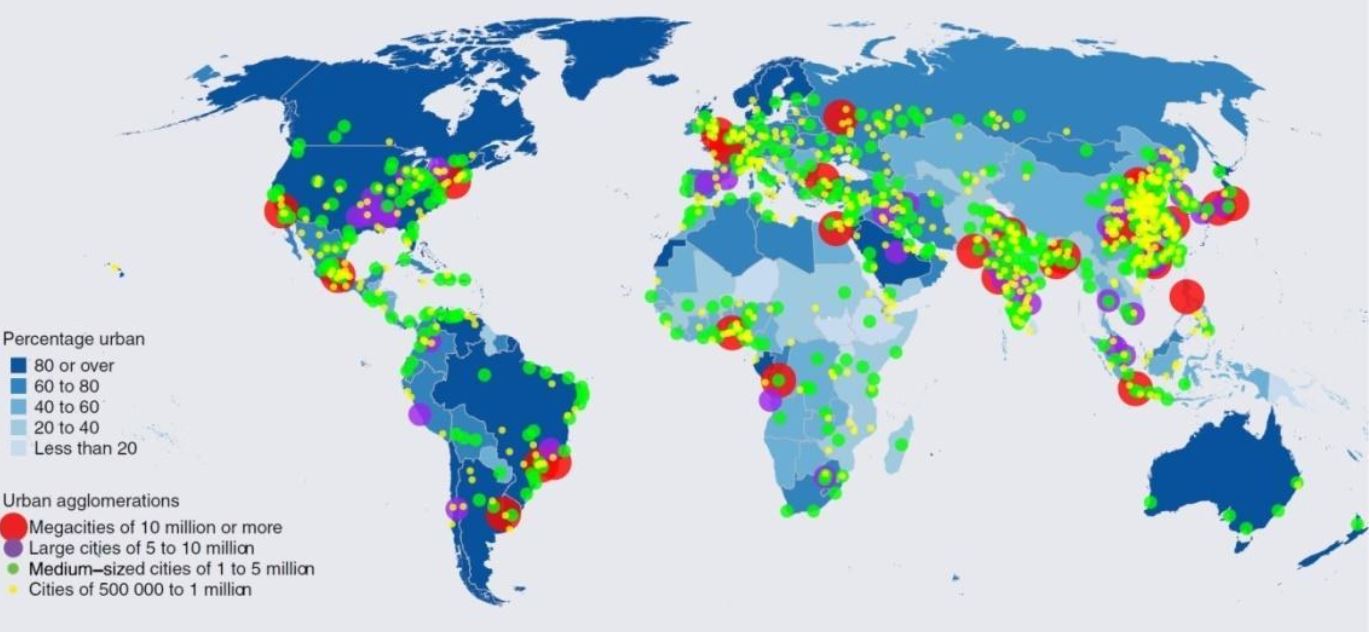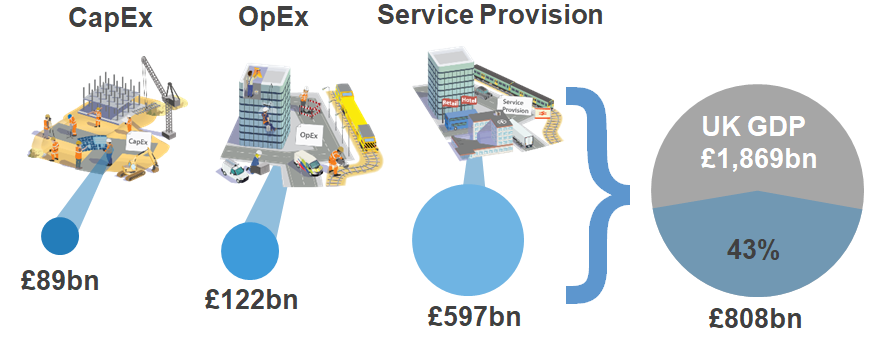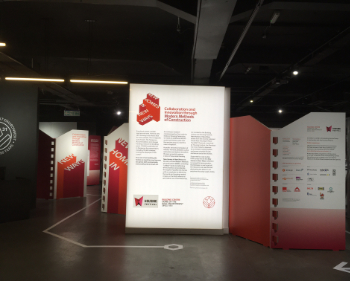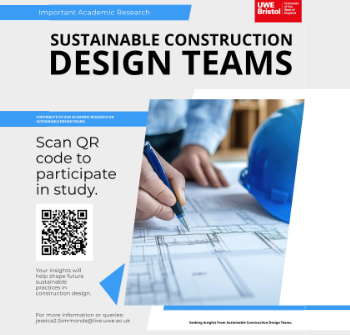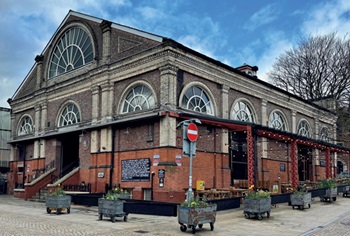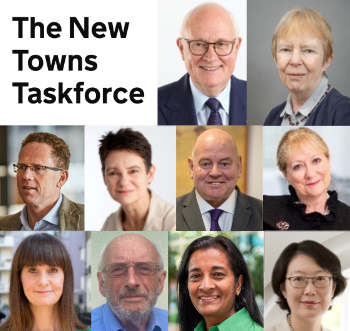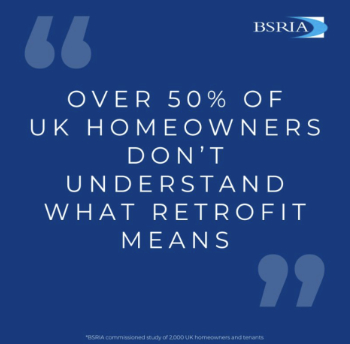How Latin America and the Caribbean can unlock their digital potential
[edit] Introduction
How can Latin America and the Caribbean (LAC) learn from other nations and accelerate the digitisation of its built environment and service sector to encourage innovation in advanced urban services, through digitising new and existing infrastructure and real estate assets?
More than 80% of the population in the LAC region lives in cities – compared to 40% in 1950.
Percentage urban and location of urban agglomerations with at least 500,000 inhabitants, 2014. [Image: UN, World Urbanisation Prospects: The 2014 Revision, Highlights]
LAC countries have some of the highest levels of urbanisation globally but one of the lowest levels of digitisation, as well as very low levels of technology adoption rates compared to other markets. The charts below illustrate how the region is already lagging behind global trends.
There is a positive correlation between digitalisation index as well as technology adoption and urbanisation. However, Latin American countries are underperforming in both dimensions. [Image: BBVA]
However, according to the Inter-American Development Bank (IDB), the internet has opened new opportunities for LAC economies to become more productive, expand opportunities for entrepreneurship, and drive inclusive economic growth.
A recent IDB report concludes that Latin America’s trade patterns are unlikely to be immune to the ongoing digital revolution, with the internet providing key benefits, including 'enabling buyers to find and evaluate sellers anywhere in the world, the internet reduces the geographic distance which for centuries has limited visibility'. IDB identifies four ways in which the internet can be used to shape LAC trade patterns:
[edit] 1. Expansion of trade in services
Traditionally known as an exporter of manufactured products and commodities, LAC nearly doubled trade in services in 2000-2013. The internet is playing a growing role in the service revolution, fuelling the region’s cross-border trade in services, such as financial, logistics, and educational services.
App development platforms enable local startups to create their own global technology companies and to export apps and digital services to customers around the world. Online micro-work platforms are expanding opportunities for Latin American freelancers and small businesses to engage in 'trade in tasks.'
[edit] 2. Increased exports and export diversification
The internet is increasing LAC companies’ trade in goods. For example, eBay’s data shows that in Chile, 100% of online sellers export, on average selling to 28 different markets – as opposed to the mere 18% of Chilean offline companies, which typically export to just two markets. These patterns are echoed in other LAC markets.
As more LAC companies become able to set up online stores and start selling and buying on e-commerce platforms such as MercadoLibre and Alibaba, the region’s prospects to expand small business trade multiply.
[edit] 3. Streamlined trade and supply chains
The internet not only enables companies to do more trade, but to optimise their trade – streamline logistics, gain foreign market intelligence, carry out payments and access financing, gain information about trade compliance and overall improve the various aspects that go into doing cross-border trade and transactions.
Using the web and various platforms, they can uncover best-in-class suppliers and shop around for the best deal worldwide. This is beneficial: businesses that are able to access a wide variety of goods and services inputs at world prices are widely shown to grow more productive and competitive.
[edit] 4. Genuinely regional small businesses and start-ups
The internet enables 'born-digital' companies to launch in several markets in rapid sequence. The full suite of turnkey internet tools and apps are enabling companies to instantly translate their websites and social media presence, target their services to new markets, understand where consumers are searching for their products, and build a local following for their brand.
By leveraging cloud-based tools, entrepreneurs in LAC can instantly build a global footprint, run anything from an e-commerce site to a bank to a genomics company, and handle millions of requests per second without building their own IT infrastructure. As a result, capital expenditure is less and barriers to enter new markets are far lower than they are in the traditional industries – and even traditional industries are increasingly leveraging the internet to manage global communications, engage with supply chain and collaborate across borders.
[edit] Turning challenges into opportunities
To enable new digital advanced urban services, increase exports, streamline supply chains and foster digital entrepreneurship in LAC, the required underlying infrastructure and real estate assets need to be digitised as well.
Only an integrated digital twin of the built environment will be able to unlock the full potential of the virtual outcome-based service provision, by linking the end-user with the physical and virtual asset through sensors and actuators. Therefore, how can the digital, construction and urban service sectors be encouraged to work together to enable the necessary transformation that enables LAC citizens of the future to benefit from world class services and opportunities?
To improve our built environment and unlock advanced urban services there are two key questions:
1. How can we build assets better and how can we upgrade the existing assets?
2. How can we ensure we build the right assets for the future?
The first issue is a construction challenge. We need assets that are available on time and on budget and perform in the way we expect. The current sector is fragmented, has failed to invest in skills and machinery, and has allowed itself to be commoditised by the market, while failing to commoditise itself.
Most clients are non-industry experts and can only use price as a yardstick of performance, which has driven a 'race to the bottom', with quality and investment becoming progressively more unaffordable. The sector must transform both in the digital and product spaces or disruption will come from the digital and manufacturing sectors. The rate of demand for social and economic infrastructure cannot be sustained by the current model.
The second issue has to do with the sector’s almost impervious ability to learn from its mistakes. We need to analyse the performance of our assets and how citizens consume the services they provide to ensure that we can invest in new assets that enable the outcomes we desire. The built-asset product is often a very complex machine and is normally populated with even more complex humans, but we fail to systematically measure how services and consumers use the assets and how they perform in service. This is an area where the digital sector will take ground. The opportunities and transparency enabled will drive both economic and public behaviours when the poor performance of assets and services are laid bare.
Monetising the digitised built environment requires a better understanding of the relationship between the capital design and the delivery process that creates new infrastructure capacity. Full life-cycle considerations become more transparent using digital models that monitor operational and maintenance costs and ensure the majority of existing assets have positive impact on the social and economic fabric of society.
EY has monetised this for the UK market. As part of the ongoing UK government support of digital transformation, it has supported the provision of a sector deal worth £170 million, announced in the December 2017 budget.
EY Analysis of UK construction, operations and services markets (2017). [Image: EY/ONS, gov.uk, Gazprom, Facilities Management Journal, Arcadis]
Since urbanisation plays an important role in explaining demand for digital products and novel advanced urban services, the LAC region could leverage its high urbanisation levels to improve digitisation adoption and as a consequence could improve the delivery of smart and connected assets to enhance the regional economy.
To enable a successful implementation, approaching how social and economic infrastructure and real estate is planned, built, maintained and used needs to be transformed entirely. The digitisation of the built environment could revolutionise how we innovate in service provision and how we build and deliver the underlying infrastructure and real estate assets.
According to Peter Madden, former CEO of Future Cities Catapult, an international centre of expertise on urban innovation: “The market for these services is huge. With the speed and scale of urbanisation creating exceptional demand in the world for services and integrated solutions in the world’s cities, investment into cities and their infrastructure over the next decade alone is likely to be over $20 trillion.”
Globally, current efforts to apply digital tools, standards and processes in the built environment are highly fragmented. While upstream stakeholders such as architects, engineers and constructors increasingly use Building Information Modelling (BIM) to improve collaboration, downstream players pilot Internet of Things-based/smart-city and data-driven solutions.
However, these initiatives are not yet integrated: data is poorly shared, use cases are limited in scope, and open platforms are missing. A process-driven integrated BIM across assets, sectors and the full life-cycle could unlock significant value and create new Advanced Urban Services.
A new global initiative of the World Economic Forum will focus on curating the required multi-stakeholder dialogue; will develop policies and practical insights that through digital technology deliver more capacity out of the existing built environment; and will demonstrate open-platform concepts of the digitised built environment through pilots.
[edit] Adopting global learnings to leapfrog in the region
The LAC market has the advantage of being able to observe a number of nations who have been early movers in this space to ensure all relevant learning can be gathered to inform future interventions. The following are recurring themes from around the globe:
[edit] 1. Transformative change through systemic leadership
A new type of leader is required to move the challenge of poor national and infrastructure sector productivity away from single capex decisions, to the creation of an end-to-end 'Advanced Urban Services' (AUS) approach, linking supply-side and demand-side of the market to ultimately address systemic urban problems and global challenges.
The key question is what system (or system-of-systems) and cultural changes would be required to get there? The future demands collective leadership that is visionary, innovative, agile and adaptable. In this context, system theory reframes leadership by focusing on the dynamic interactions between all individuals, explaining how the interactions can, under certain conditions, produce promising outcomes.
The profound changes needed to accelerate progress on society’s most pressing problems require distinctive leaders. The recent literature on organisational behaviour calls them systemic leaders – able to lead organisations, systems, industries, communities and even nations through transformative change.
[edit] 2. Breaking silos using a multi-stakeholder approach
To bring together policymakers, planners, designers, (software)engineers, architects, data managers, modellers, AUS providers, financiers, investors, maintainers, contractors, trades and suppliers, and manufacturers to understand how waste and value are manifested and dramatically better managed. We need to raise awareness of this required new approach by activating key stakeholders that can disrupt silos and change the conservative culture of the infrastructure and built environment-related industries.
The PalaceXchange scheme used technology to enable collaborative working across silos. It involved the erection of a civic building comprising three-storey civic/library accommodation. This was connected by a new footbridge to a 530-space multi-storey carpark below including three leisure use compartments. It provided 14,000 sq. m of new retail space in 22 shop units and 6,038 sq. m of leisure and cultural venues and a link between the town’s top high street retailers.
The contractor Costain wished to improve their processes to deliver a high quality end product with less waste in the design process. The clients, ING Real Estate, were keen to make good use of technologies and techniques to encourage information exchange and collaboration, make the construction process more efficient and reduce the operational costs. The client and contractor felt that a BIM could help to improve spatial coordination and produce better quality information with a reduction in Requests for Information (RFI).
The findings from impact analyses, has been sufficient for Costain and Reid Architecture to express commitment to the implementation of the BIM approach on this and other projects. They felt that the major benefit of improved spatial coordination was the delivery of the project 10% under budget. Some members of the team have adopted the principles and have used BIM in subsequent projects.
The important point here is the link between digital technology and an integrated lifecycle approach. The two are symbiotic, reinforcing one another. By taking a whole lifecycle perspective across design, build and operations, it becomes possible to design assets that are faster, cheaper and safer to construct and more fit for purpose when in operation. Digital technology enables this.
For example, design reviews using virtual reality allow are parties to review how an asset will really look and feel, and improve the design accordingly. And, going forward, the power of machines can be harnessed to run multiple iterations to identify designs that optimise on any required output, such as cost to operate, or speed to construct.
[edit] 3. Applying human/social-centric design and infrastructure as a service
To focus on positive impact on the citizen, the future customer’s and society’s needs and interests such as wellbeing, longevity, increased utility, purpose, etc. to design excellence into the AUS delivery. A human and social-centric, aka an empathic design approach has to be adopted to better define the requirements of supporting smart, adaptive and flexible infrastructure and built environment asset programmes.
New design thinking-based processes have to be adopted to generate promising ideas, assess value generation potential of assets and develop and verify sound business models for assets underlying the AUS. The potential is substantial considering that we might not even imagine 90% of future AUS.
[edit] 4. Transforming the industry sector into a smart business
To apply key success factors for innovation in the infrastructure and built environment ecosystem, AUS innovation has to be analysed on three dimensions during the strategic multi-stakeholder dialogue:
- Stimulating innovation by focussing on vision, culture and talent.
- Turning ideas into reality by designing product platforms, proof of concepts, pilots and prototypes as well as strategic partnerships.
- Succeeding in the market by accelerating business model innovation, introducing alternative contracting models as well as proactively shaping regulation.
[edit] 5. Transforming the public sector into a smart government
There are three agile and flexible roles for governments to foster the adoption of innovation in the infrastructure and built environment ecosystem:
- Becoming a smart regulator by harmonising and reforming regulation, codes and public procurement towards fast, agile, flexible and performance-based frameworks.
- Becoming a long-term strategic planner and incubator by introducing an innovation agenda, increasing R&D funding in the built environment sectors as well as the necessary, seed financing to unlock innovation opportunities.
- Becoming a forward-looking project owner that embraces an innovation friendly culture, a lifecycle perspective, alternative procurement models as well as data analytics.
The UK government, through its construction strategy 2011-16 and subsequent follow up schemes, pioneered the large-scale transformation of an industry. The government strategy set clear targets for cost, carbon, programme and export improvements. It used procurement strategy to implement the strategy, with clear client 'Employers' Information Requirements' to provide clear specifications to industry as to the data to be delivered with their assets.
The programme was supported with a number of supporting interventions such as Soft Landings (a user and operator engagement and support programme), Project Bank Accounts (a mechanism to ensure SME businesses receive fair and on time payments), and alternative procurement approaches. Project savings in FY14/15 ranged between 8%-12% of capex across the public sector.
[edit] 6. Fostering public-private cooperation
To identify concrete projects, prototypes, pilot studies for application. A state-of-the art example in combining public private cooperation and using digital twin is the The Karolinska Hospital and Institute in Stockholm, a globally renowned healthcare institution.
In 2010, construction for the New Karolinska Solna (NKS) Hospital started. With an overall investment of $3 billion and a contract to extend until 2040, it is considered to be the world’s largest hospital public-private partnership. When completed, the hospital will have over 12,000 rooms, 35 operating theatres and 17 magnetic resonance imaging (MRI) units.
Aiming to set new standards in patient care, integration of healthcare and research, adaptability to future needs and sustainability, the NKS project involves many innovations in the construction process and in operations and maintenance (O&M).
The key innovation is the development and use of an advanced BIM that will be used across the entire lifecycle. Once completed the model’s object list will have about one million items and can be accessed from anywhere by construction workers, project managers or contractors. Without 'digital snagging', i.e., identifying potential issues and communicating them via a virtual punch list before handover, the smooth handover of the building would simply not have been possible.
But, the best is yet to come – the maximum potential of the BIM model will be realised during O&M, making that phase as efficient as possible thanks to predictive maintenance, quicker repairs and optimised facility management. This includes 29 automated guided vehicles that will autonomously conduct logistics within the hospital and between the different buildings, and which use the BIM model as an address book.
What’s more, the hospital construction sets new standards in terms of sustainability (climate neutral, LEED Gold) and also took advantage of prefabrication of entire rooms to facilitate logistics and speed up construction. The 29 automated guided vehicles will autonomously carry out about 1,600 transports per day.
[edit] Call for action
The impact of digitisation has been slow to reach the built environment ecosystem, but through the early moves of some significant players there is now an awareness of the potential and a disruptive effect is being felt. However, for the LAC nations to capitalise on the opportunity in a timely manner they need to incentivise the market through a number of interventions to generate opportunities for new business to provide society with sustainable, affordable assets that fulfil human needs.
CEOs of leading sectoral companies at the World Economic Forum Annual Meeting 2018 prioritised three transformation imperatives: attracting new talent and improving skills to unlock a dormant digital market, integrating and collaborating across the built environment value chain, and adopting advanced technology on a large scale.
Furthermore, operators and service providers should start collecting data regarding the performance and usage of assets to provide structured feedback to customers and future interventions. Where possible, this data should be made available as Open Data to encourage the digital market innovators to develop new solutions.
In addition, the manufacturing sector should be encouraged to enter the market at scale to increase choice and quality, while decreasing price. The public sector should follow procurement models that promote on time and on budget delivery of assets.
At the same time, the consideration to the private sector should be linked in performance to a set of preferred outputs. This is expected to promote innovation and efficiencies throughout the life cycle of the assets. The construction sector should be incentivised to 'deliver assets properly' to time, quality and budget and increasingly at scale. The components they use should become intelligent and smart.
This article was written by:
- Mark Bew, Chairman Professional Construction Strategies, Strategic Advisor to Digital Built Britain, United Kingdom
- Mike Burke, Chairman and Chief Executive Officer, AECOM, USA and Co-Chair of the Steering Committee, Infrastructure and Urban Development Industries, World Economic Forum
- Michael Buehler, Head of Infrastructure and Urban Development, World Economic Forum, Geneva, Switzerland
Please find the original article here.
--Future of Construction 13:52, 15 Mar 2018 (BST)
[edit] Find out more
[edit] Related articles on Designing Buildings Wiki
- 3 ways the world’s fastest growing economies can close the infrastructure gap.
- A better investment framework for Africa.
- Global Construction 2025.
- India needs to build more infrastructure fast. Here’s how.
- State of the construction industry in Uganda.
- The New Silk Road.
- These giant infrastructure projects are set to reshape Africa.
- Why the West has to join the Belt and Road Initiative.
Featured articles and news
About the 5 Percent Club and its members
The 5% Club; a dynamic movement of employers committed to building and developing the workforce.
New Homes in New Ways at the Building Centre
Accelerating the supply of new homes with MMC.
Quality Planning for Micro and Small to Medium Sized Enterprises
A CIOB Academy Technical Information sheet.
A briefing on fall protection systems for designers
A legal requirement and an ethical must.
CIOB Ireland launches manifesto for 2024 General Election
A vision for a sustainable, high-quality built environment that benefits all members of society.
Local leaders gain new powers to support local high streets
High Street Rental Auctions to be introduced from December.
Infrastructure sector posts second gain for October
With a boost for housebuilder and commercial developer contract awards.
Sustainable construction design teams survey
Shaping the Future of Sustainable Design: Your Voice Matters.
COP29; impacts of construction and updates
Amid criticism, open letters and calls for reform.
The properties of conservation rooflights
Things to consider when choosing the right product.
Adapting to meet changing needs.
London Build: A festival of construction
Co-located with the London Build Fire & Security Expo.
Tasked with locating groups of 10,000 homes with opportunity.
Delivering radical reform in the UK energy market
What are the benefits, barriers and underlying principles.
Information Management Initiative IMI
Building sector-transforming capabilities in emerging technologies.
Recent study of UK households reveals chilling home truths
Poor insulation, EPC knowledge and lack of understanding as to what retrofit might offer.









